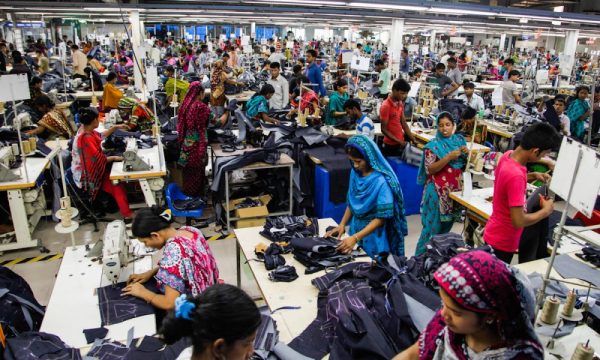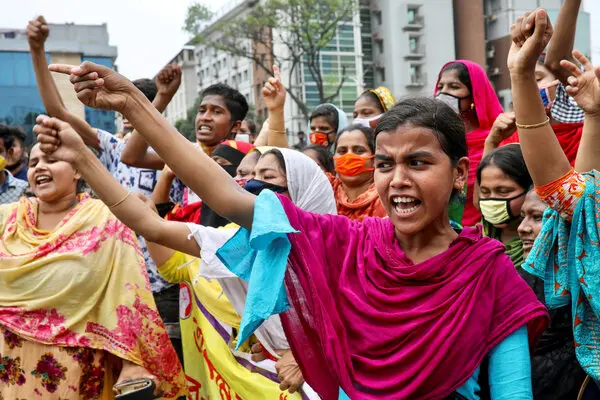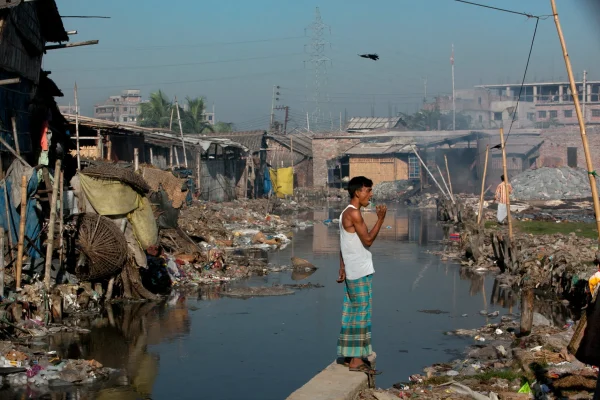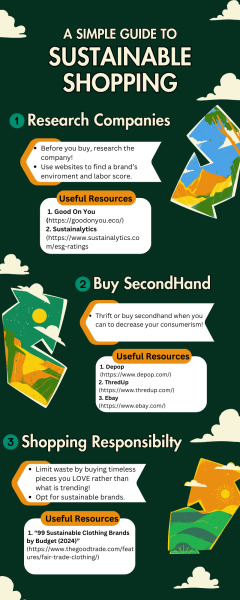Shein. H&M. Zara. Brandy Melville. Urban Outfitters. Consumers desire the newest, hottest, and celebrity-endorsed styles. Thus, companies have increased production speed in order to accommodate consumer demand. This means of production is known as fast fashion. However, fast fashion’s accelerated trend and production cycle are unsustainable, posing significant humanitarian and environmental concerns.
Humanitarian Impact
The key appeal of fast fashion is its low and competitive prices; nevertheless, these prices are only feasible at workers’ expense. To maximize profits and production, fast fashion companies utilize sweatshops. Sweatshops are factories that violate at least two labor laws and, in turn, foster dangerous and unethical working conditions. While numerous sweatshops are located in the United States, the majority are found in countries throughout Asia, such as India, Bangladesh, Vietnam, China, Indonesia, and Cambodia. Companies, predominantly American-owned, exploit third-world countries due to the extreme poverty levels, lack of established or enforced labor laws, and overall increased vulnerability. As a result, sweatshops fly under the radar and perpetuate their exploitative practices.

Since the discussion surrounding the ethical implications of the fast fashion industry gained momentum, multiple sources have unveiled evidence demonstrating the deplorable working conditions found in various sweatshops. For example, one of the most prevalent abuses is significantly insufficient wages. Sweatshop workers have been reported to make less than 1 US dollar an hour, with the average being 33 cents per hour in Bangladesh. In addition, while investigating the extensive garment industry in California, the U.S. Department of Labour concluded that 80% of sweatshops violated minimum wage and overtime laws. These infringements equated to around $892,000 in back wages and damages. Moreover, a majority of fast fashion workers are not paid an established rate and are instead paid on commission. An investigative documentary on Channel 4 called “Untold: Inside the Shein Machine” obtained undercover footage of a Shein factory in which workers were paid 0.27 yuan, or around 4 US cents, for each garment produced. Thus, to make the United States federal minimum wage of 7.25 dollars per hour, workers would have to produce around 181 garments.

Inadequate salaries are only the tip of the iceberg. In many instances, working conditions in garment factories are comparable to slave labor. This treatment tends to disproportionately impact one specific demographic: women. Systematic sexism is woven throughout the fast-fashion industry. As a result, women make up 80% of all garment workers and work exclusively on production, while men assume managerial positions. This distinct hierarchy contributes to the prevalence of gender-based violence in these workplaces. For instance, in 2018, H&M and Gap underwent intense scrutiny due to two reports the Global Labour Justice released. Within these reports were 540 accounts of workers who experienced threats or abuse in factories that manufacture for H&M and Gap. In one particular account, a woman recalls an occasion where a male superior brutally beat her for failing to meet a production quota. Situations similar to the latter, where a female worker is degraded, called obscenities, sexually harassed or physically assaulted, are a common occurrence. Sweatshops also commonly require female workers to undergo routine pregnancy tests. This “protocol” is established to ensure workers can endure the long and grueling hours expected of them. On average, sweatshop employees are expected to work 10–12 hours a day, but there are numerous instances where they are reported to work 16–18 hours a day. Consequently, when a worker becomes pregnant, their ability to work is compromised, often leading to termination.
Environmental Impact
Fast fashion’s promotion of consumer and throw-away culture has led to an exponential growth of textile waste over the past two decades. The majority of these discarded garments are deposited in landfills. To illustrate, The United States Environmental Protection Agency (EPA) concluded that in 2018, 17 million tons of textile waste were produced, and 11.3 million tons ended up in landfills. This staggering amount of waste and its corresponding effects have only increased as the fast fashion empire expands.
Landfills emit numerous hazardous gasses; the most worrisome include ammonia, sulfides, methane, and carbon dioxide. The inhalation of these gasses is linked to serious respiratory illnesses. Thus, numerous studies have highlighted that populations surrounding landfills face acute health risks, with a majority of these sites disproportionately located near communities of color and low-income neighborhoods. Research conducted in North Carolina revealed that areas where more than half of the population are people of color are 2.8 times more likely to have a solid waste facility than areas where less than 10% of the population are people of color. Likewise, areas where the average house value is less than $60,000 were 1.5 times more likely to have a solid waste facility than areas where the median house value is $100,000 or more. Moreover, the environmental impacts of landfills extend beyond air pollution, contributing to soil and water contamination. Landfills tend to produce leachate, a liquid that forms when rainwater percolates through garbage in landfills, picking up harmful chemicals such as increased amounts of ammonia. These additional quantities can detrimentally affect ecosystems’ equilibrium. For instance, the ammonia converts to nitrate, which can then lead to eutrophication or a lack of oxygen due to excessive plant growth. This results in “dead zones” that are unsuitable to sustain wildlife. Thus, landfills foster significant health and environmental risks, while setting the stage for other large-scale effects, such as global warming.
Since the late 1900s, CO2 emissions have been at the forefront of the climate crisis. Nevertheless, as of the twentieth century, CO2 emissions have increased by 60%. CO2 emissions, or greenhouse gas emissions, refer to the unsustainable secretion of gasses such as carbon dioxide, methane, and nitrous oxide (N2O). A prevalent human activity that emits carbon dioxide is the burning of fossil fuels. Fossil fuels are burned to generate energy essential to many large-scale industries, especially fast fashion.
The fashion industry produces 8–10% of all global carbon emissions, thus establishing it as the second-leading industrial polluter. Fast fashion has set an unsustainable precedent of accelerated production that has exponentially increased CO2 emissions over the past few years. For example, Boohoo, a UK-based online fashion company owned by Nasty Gal and PrettyLittleThings, was reported to release around 588,303 metric tons of carbon dioxide in 2019. By 2021, this rate would have increased to 1,022,034 metric tons.
Once carbon dioxide is released into the atmosphere, it traps heat and contributes to global warming, or the significant increase in temperature worldwide. Global warming is linked to numerous catastrophic climate changes, including rising sea levels, droughts, severe storms, etc. While troubling enough alone, these changes are the precursor to a plethora of connected adverse effects. For example, increased periods of drought led to devastating wildfires, which in turn threatened biodiversity and exponentially escalated species’ probability of extinction.
Due to its key role in irrigation, the Buriganga River was an essential part of countless Bangladeshis’ livelihoods. However, over the past few decades, the once flourishing river has transformed from a resource to a hazard. As of 2020, the Buriganga is completely black, omits a foul smell and is overall unsuitable for wildlife and human use. The timeline of this drastic shift correlates with one significant infrastructural development in Bangladesh: garment factories.

Fast fashion is not only one of the top consumers of water but is also responsible for 20% of all global wastewater. To cut costs, many fast fashion companies have shifted towards synthetic fabrics. These fabrics, such as polyester and nylon, are made from plastics, which require 70 million tons of oil per year. Throughout the processing of synthetic fibers, pollutants, including arsenic, benzene and lead contaminated water sources. Additionally, garments consisting of synthetic fibers release thousands of microfibers, which then easily pollute large bodies of water and take centuries to decompose. Every year, around half a million tons of microfibers are disposed of in the oceans. This, in turn, has threatened ecosystems and even humans’ diets.
Along with microfibers, sweatshops also contribute to water pollution throughout other stages of production, such as fabric dying. Factories tend to utilize harmful dyes and chemicals that compromise bodies of water and populations in proximity. The most notorious of these dyes are known as anthraquinone or azo dyes. Azo dyes are derived from molecules containing the azo group, which consists of a double bond between two nitrogen atoms. Unlike other dyes, azo dyes produce strong, vivid results without requiring a costly or extensive manufacturing process. While cost-efficient, the adverse impacts of these dyes and their utilization significantly outweigh any desirable aspects. To expand, especially during the stage of fabric dying, fast fashion companies discard substantial volumes of wastewater in surrounding rivers, streams, etc. This water waste contains numerous hazardous chemicals, including pesticides, heavy metals, and azo dyes. When in contact with human skin, azo dyes can be absorbed and then metabolized by intestinal bacteria. Throughout this process, a portion of the metabolites produced are classified as carcinogenic, which means they increase an individual’s susceptibility to developing cancer. With this concern and azo dyes’ linkage to other adverse health effects, such as allergies, multiple countries have outlawed or regulated the dye’s usage. For example, azo dyes are banned in countries including China, Japan, India, Vietnam, and the European Union. While there are relatively zero restrictions surrounding azo dyes in the United States, California established Proposition 65, in which business owners are legally obligated to provide warnings on products containing hazardous chemicals that can result in birth defects or other reproductive harm. Azo dyes are composed of around 20 different carcinogens, as highlighted in this proposition.
The prevalence of the fast fashion industry and its correlated adverse impacts have not gone unnoticed. With greater media coverage, consumers are now more aware of their favorite brands’ exploitative and unsustainable nature. This awareness has sparked a widespread movement towards boycotting fast fashion and seeking out more sustainable alternatives. Consequently, companies have had to adapt their marketing tactics, leading to the emergence of greenwashing. Greenwashing is a form of rhetoric commonly employed by fast fashion brands in which false or misleading claims of sustainability are utilized to portray the company as environmentally conscious. Despite many companies pledging to “go green” and improve working conditions, these commitments often remain unfulfilled or fail to offset the damage caused by the brand. As long as these companies continue to profit, they are unlikely to amend their unethical practices. Therefore, in order to combat the negative humanitarian and environmental impacts of fast fashion, the majority of the responsibility falls on one party: you, the consumer.
Resources:
https://www.ncbi.nlm.nih.gov/pmc/articles/PMC7380204/
https://www.mdpi.com/2075-471X/8/4/24
https://www.unep.org/news-and-stories/story/environmental-costs-fast-fashion
https://www.britannica.com/money/topic/sweatshophttps:/
/www.theguardian.com/global-development/poverty-matters/2011/apr/28/sweatshops-supplying-high-street-brands
https://www.dol.gov/newsroom/releases/whd/whd20160224-0
https://www.europarl.europa.eu/EPRS/140841REV1-Workers-conditions-in-the-textile-and-clothing-sector-just-an-Asian-affair-FINAL.pdf
https://blog.dol.gov/2023/03/21/the-exploitation-of-garment-workers-threading-the-needle-on-fast-fashion
https://oehha.ca.gov/proposition-65/about-proposition-65#:~:text=Proposition%2065%20requires%20businesses%20to,are%20released%20into%20the%20environment.
https://www.epa.gov/facts-and-figures-about-materials-waste-and-recycling/textiles-material-specific-data
https://www.ncbi.nlm.nih.gov/pmc/articles/PMC6617357/
https://www.ncbi.nlm.nih.gov/pmc/articles/PMC1964896/
https://www.fairplanet.org/story/how-the-fashion-industry-pollutes-our-water/#:~:text=The%20increase%20in%20demand%20generated,the%20textile%20industry’s%20water%20pollution.
https://www.worldbank.org/en/news/feature/2019/09/23/costo-moda-medio-ambiente
https://www.cnn.com/style/article/dyeing-pollution-fashion-intl-hnk-dst-sept/index.html
https://www.theguardian.com/global-development/2018/jun/05/female-garment-workers-gap-hm-south-asia
https://www.colorado.edu/ecenter/2021/04/15/hidden-damage-landfills#:~:text=Environmental%20Impact%20of%20Landfills&text=Along%20with%20methane%2C%20landfills%20also,create%20smog%20if%20left%20uncontrolled.
https://www.cnbc.com/id/100893344


![The [Fabric]ated Lies About Fast Fashion](https://ssanews.org/wp-content/uploads/2024/04/100896727-171842609r.jpg)